Finding a fresh, young chicken of the woods mushroom is one of the best things to happen to a mushroom forager. These mushrooms are delicious! They have a super dense, meaty texture with only a slight mushroomy flavor. Their texture and mild flavor make them the perfect meat substitute in SO many dishes. Most people won’t even notice they’re eating a mushroom!
But before you start cooking these mushroom foraging treasures, you need to know the best ways to clean and prep them. Most chicken of the woods mushrooms don’t need much cleaning (another big bonus of this mushroom), but it also isn’t uncommon to find them embedded with twigs and leaves or conifer needles.
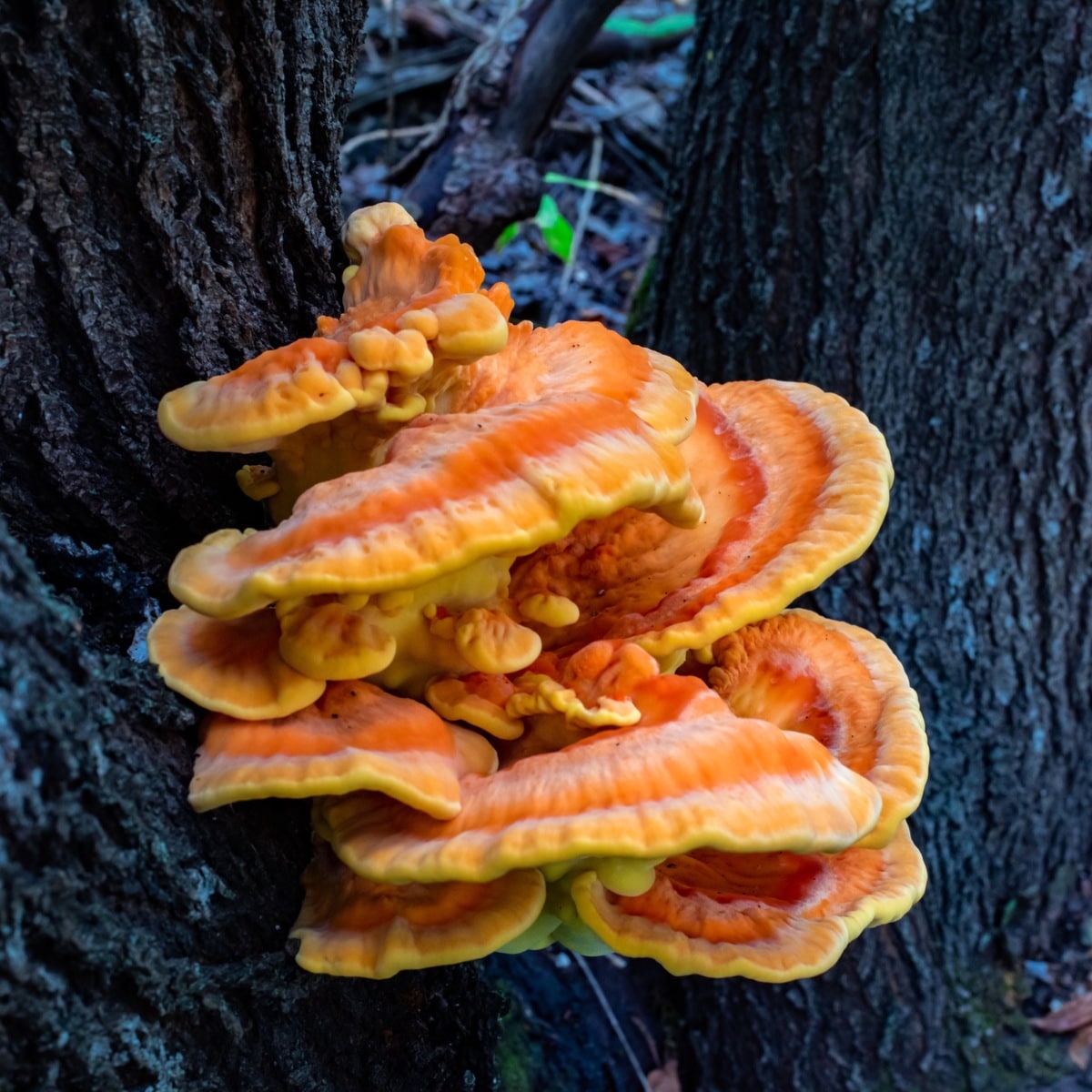
Jump to:
- How to Identify Fresh Chicken of the Woods
- Chicken of the Woods Safety Guidelines
- How To Store Chicken of the Woods
- How To Clean Chicken of the Woods
- Prepping Chicken of the Woods For Cooking
- Cooking With Chicken of the Woods
- Chicken of the Woods Long Term Storage and Preservation
- Our Favorite Chicken of the Woods Recipes
- Common Questions About Cooking Chicken of the Woods
How to Identify Fresh Chicken of the Woods
For a thorough guide to chicken of the woods mushroom identification, including how to tell it apart from lookalikes, consult this guide.
Chicken of the woods mushrooms grow in broad, fan-shaped clusters. The clusters measure 2 to 10 inches across. Some can even grow up to 2 feet wide!
Fresh chicken of the woods is bright sulfur-yellow to orange with lighter edges. The young mushrooms feel like suede to the touch. The cap surface becomes more leathery with age, and the flesh turns corky. Chicken of the woods has pores on its underside, not gills. The pores will be bright yellow or cream-colored, depending on the species.
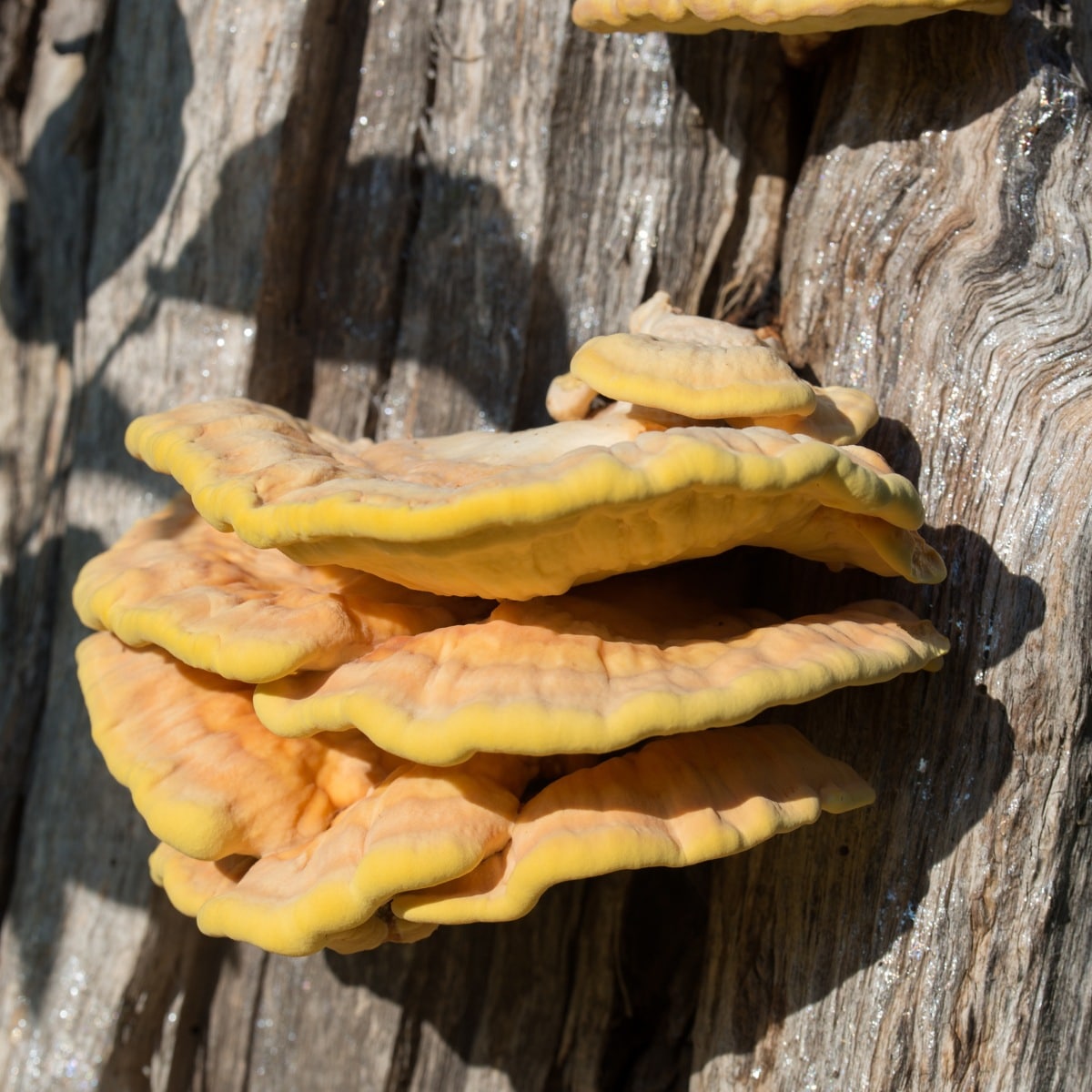
The mushrooms start as small, white “buds” that look entirely alien. As they grow, they develop the fan or bracket shapes. Very young, just forming mushrooms release moisture and sometimes drip yellow liquid when you press them. This is a sign that they are still super fresh and prime for foraging.
These mushrooms grow from trees, never from the ground (although one species appears to grow from the ground, it actually does not – it’s a trickster).
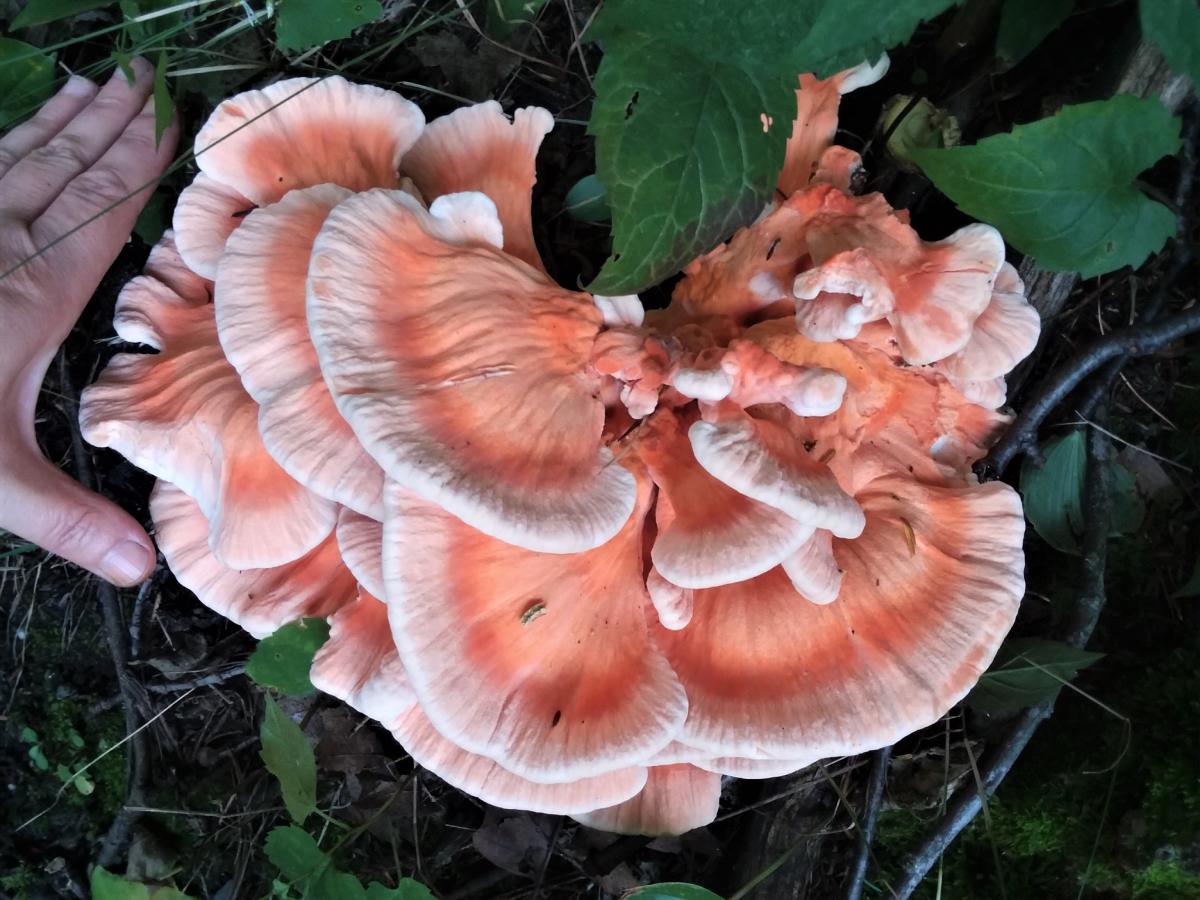
Chicken of the Woods Freshness Test
Fresh chicken of the woods mushrooms should feel slightly spongy yet firm to the touch. The color will be bright, not faded, and the flesh will easily cut.
Here are signs that the mushroom is past prime and should not be eaten:
- Dark spots or areas that look different in color by a lot
- Slimy spots on the mushroom flesh
- Flesh crumbles easily
- A knife does not cut the flesh easily
- Mold or spores you can see on the surface
You have a short window to harvest these mushrooms – from just showing up as little nubbins on the tree to fully fledged massive brackets takes about 5-7 days. Mushrooms growing near the ground or on fallen trees need extra cleaning. Look for young, tender shelves because older parts get tough and woody.
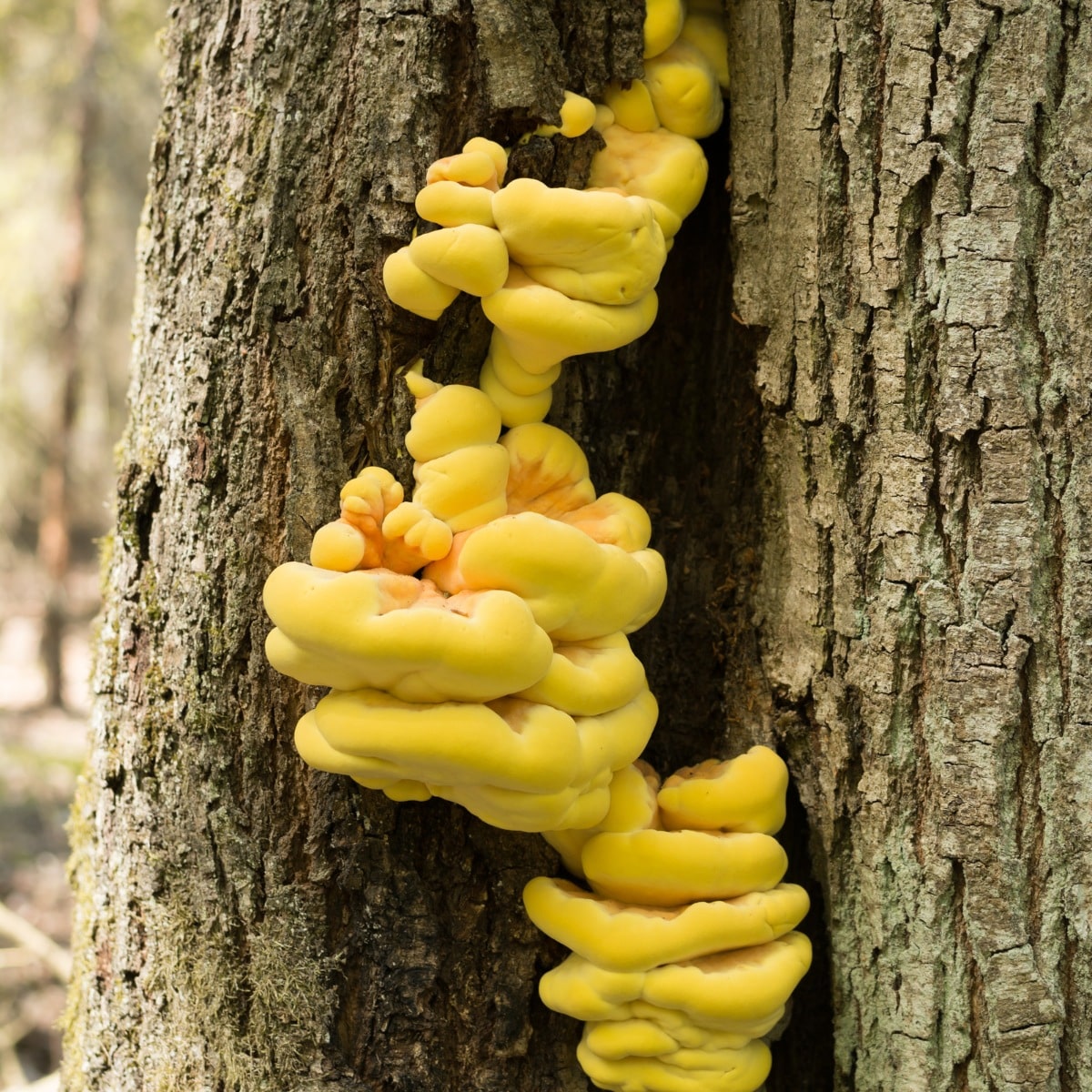
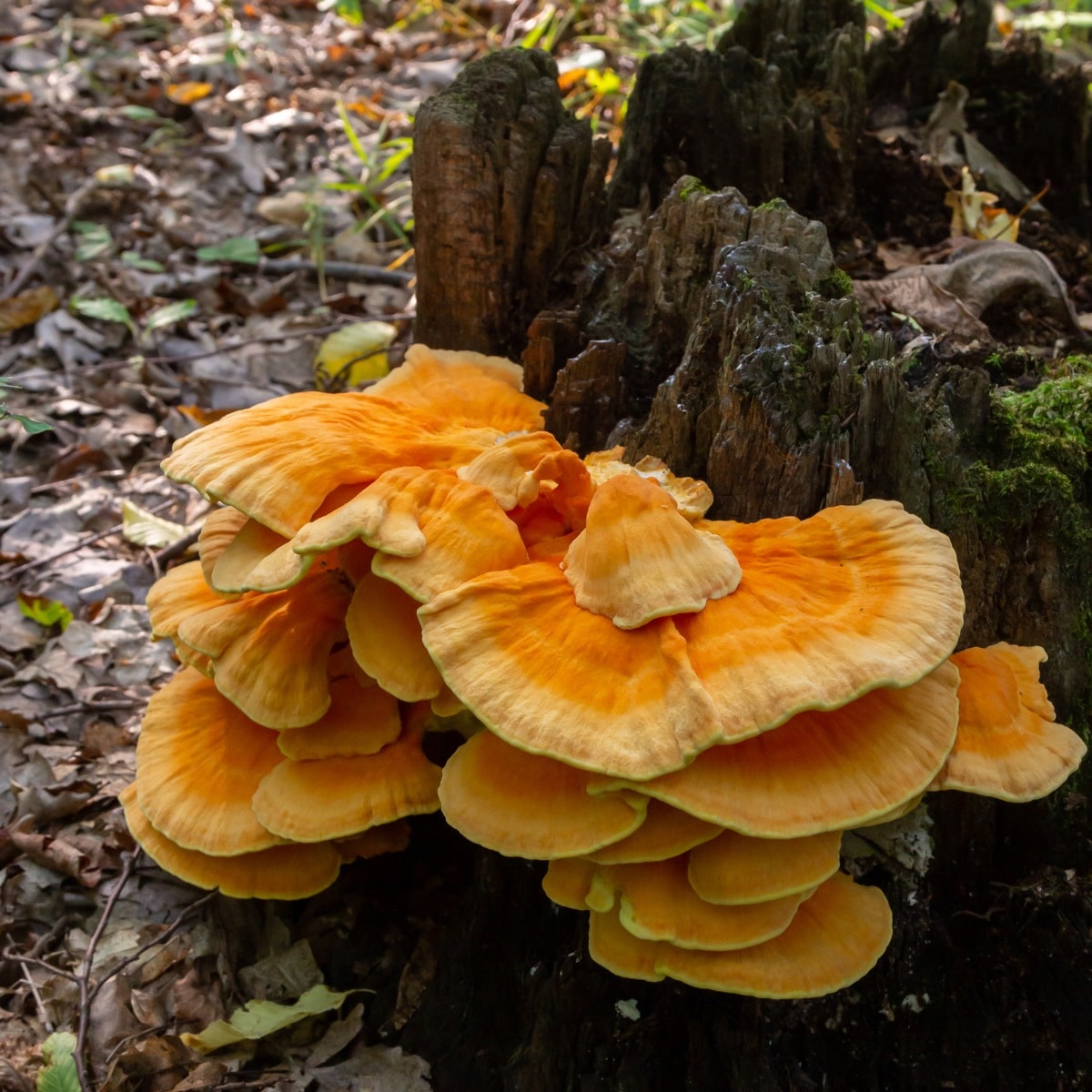

Chicken of the Woods Safety Guidelines
Many people who try these mushrooms for the first time might show sensitivity. The reactions can range from mild symptoms like swollen lips and light-headedness to more unwelcome issues like nausea and stomach problems.
In addition to the basic new food sensitivity potential, there is also possibly another issue with chicken of the woods. Many people say (and repeat over and again on social media) that chicken of the woods mushrooms foraged from conifer trees are poisonous (not deadly, but may give you severe stomach issues). While there is absolutely no scientific evidence or proof other than anecdotal, it does seem that some people are more sensitive to this mushroom when it’s growing on conifer wood.
However, and this is a big however, people have been eating chicken of the woods for centuries without any reported issues (or known reports). The toxicity reports are all somewhat recent. So, what does this mean? It is possible that the people fell ill because the mushroom was too old, not cooked long enough, or for a myriad of other reasons. Or, it could be that conifers change something in the mushroom and cause reactions for a portion of the population.
What this means for the chicken of the woods forager is up to you. This forager eats the mushroom foraged from conifers without issue. So do many others. But should you take the chance?
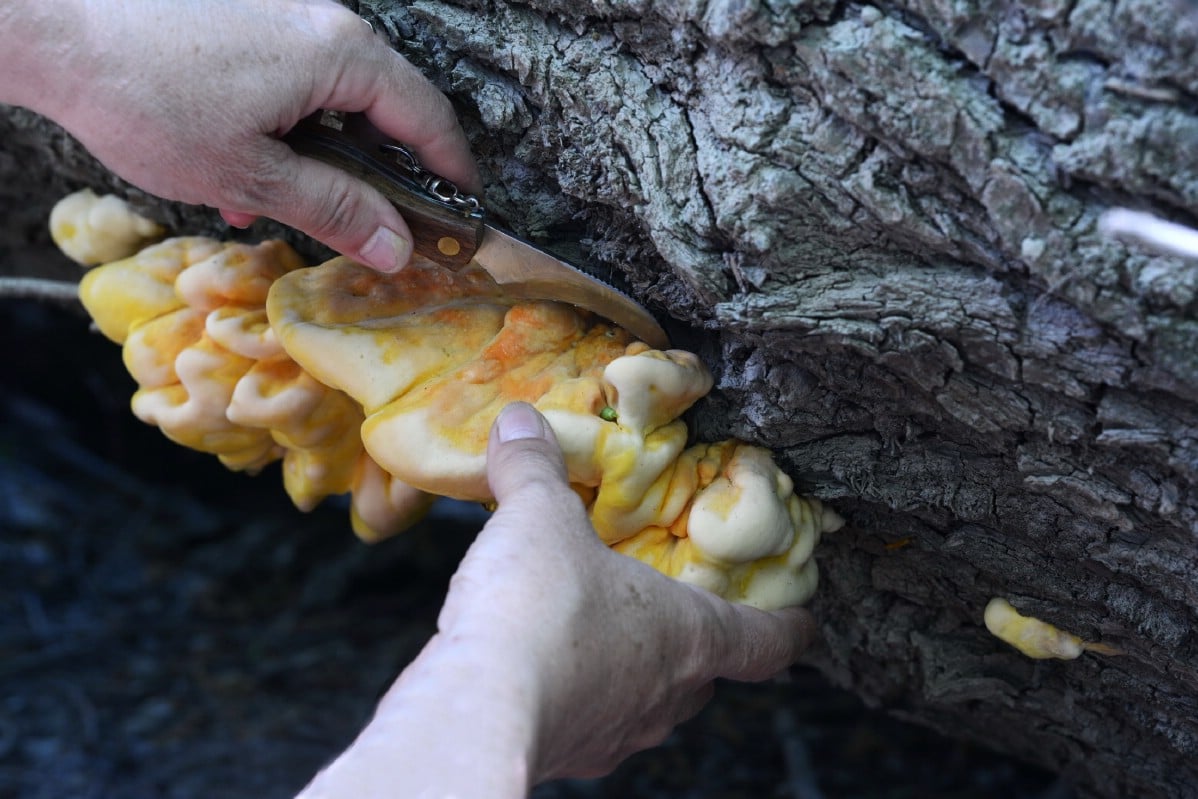
How To Try A Mushroom For The First Time
You should test your sensitivity before eating a full meal of chicken of the woods mushrooms.
- Cook a small piece really well (at least 10 minutes) and eat it.
- Wait 24-48 hours to see how your body reacts. Be aware of any adverse reactions, such as stomach problems or allergy symptoms.
How To Store Chicken of the Woods
Freshly foraged mushrooms are best stored in the refrigerator in a paper bag. Do not store them in plastic because that causes condensation to build up, and the mushrooms will start decomposing. They will stay good like this for a week. You can store them for longer, but the mushrooms will start drying out and become less enjoyable to eat.
Don’t clean the mushrooms before storing them. Only clean them right before you intend to use them. Mushrooms are prone to getting moldy if they’re stored wet in the refrigerator.

How To Clean Chicken of the Woods
Start cleaning right in the field by cutting off tough sections and keeping only the tender parts. The base of the cluster is usually pretty tough, so that can get sliced off immediately. This first step will reduce the work you need to do at home.
When you get the mushroom home, take time to look at each piece. Look the mushroom over for mushy bits and cut them off. Next, examine for dirt or bug damage. Chicken of the woods mushrooms can be super clean with very little dirt or have all kinds of debris embedded in the cap.
Foraged mushrooms that are mostly clean will only need a wipe down or quick rinse under running water. A soft-bristled brush or damp paper towel works great to wipe the mushroom caps and undersides.
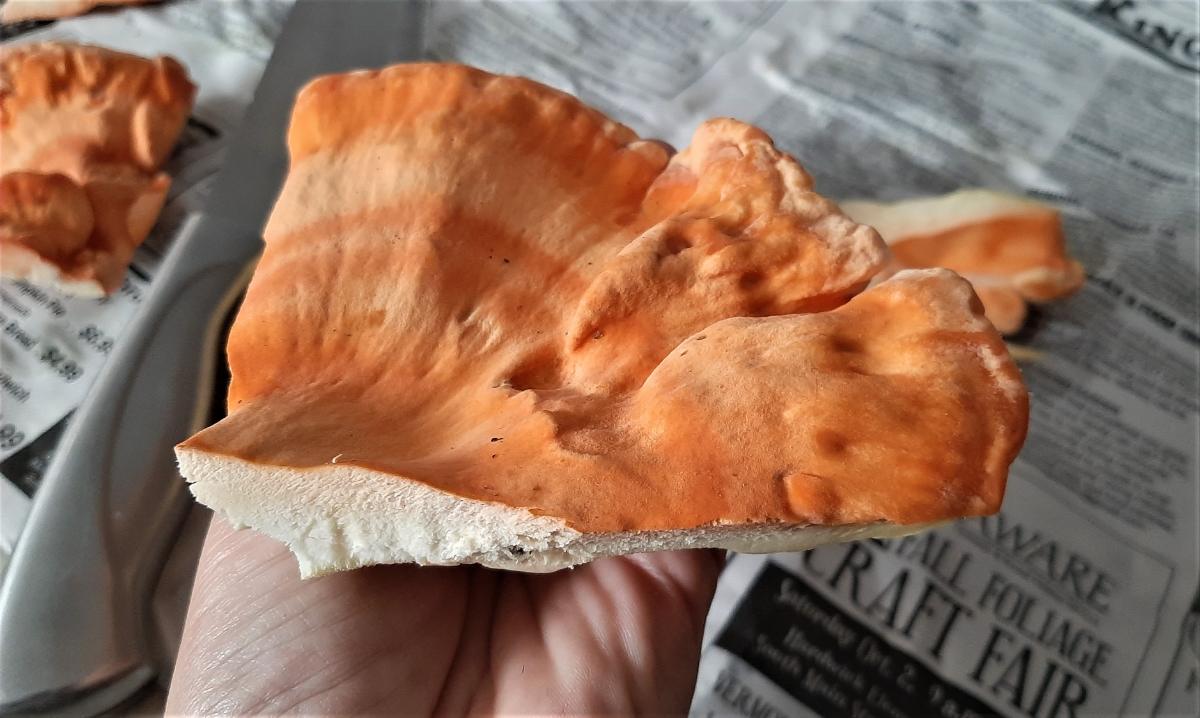
For the other dirtier mushrooms, it’s going to be much more work, depending on how deeply the debris is embedded. The easiest thing to do is cut away any tough or dirty sections you find. Though, this can have you cutting the entire mushroom into bits. Unfortunately, there’s no way around this unless you like eating twigs with your mushrooms! A paring knife works really well to scrape or cut off debris.
Take a good look at the mushroom to check for any signs of bug infestation. Look carefully at the outer lobes because fungus gnats often make homes in these spaces. Cut each mushroom in half from top to bottom to find hidden insects. Get rid of parts that show heavy bug damage or where slugs have made their homes.

Prepping Chicken of the Woods For Cooking
Look at each frond and notice the difference in size and density of the base and the outer edges. The texture changes – it is woody near where it attaches to the tree and tender at the edges. You’ll want to keep only the tender sections and remove any tough, fibrous parts.
If you’ve got a super young and fresh chicken of the woods, you may not have any tough sections at all. In that case, use the entire mushroom! Otherwise, assess the tenderness by seeing how easily a knife cuts through the mushroom flesh. If it is even slightly tough, discard that section. It will not get better with cooking.
Your mushrooms will fall into three texture categories:
- Tender tips – this is the outermost portions of the cap where the flesh is often thinner and younger.
- Meaty middle – this is the middle, denser part of the mushroom. Often, several fronds fuse together to create especially thick sections.
- Tough tree-attachment portion – this is the very base of the mushroom, and it most often needs to be discarded because it is tough. Or, you can boil and dehydrate it for a mushroom powder.
The meaty center section most likely makes up most of your harvest. Depending on the age of the mushroom, these parts might need extra moisture while cooking so they don’t dry out.
Using a marinade or plenty of cooking liquid helps maintain the tenderness. The younger a chicken of the woods is, the more likely you’ll have lots of excellent tender portions for cooking.


Cooking With Chicken of the Woods
There is so much you can do with these mushrooms. They can be substituted for any recipe calling for chicken because they have almost the exact same texture and tenderness.
Whatever method you pick, cook these mushrooms for at least 10 minutes. Never eat chicken of the woods mushroom raw.
Pan-frying
Set a heavy-bottomed skillet over medium heat. Pour enough oil to make a shallow layer, about ¼ inch deep. You’ll get better results if you add 2 tablespoons of butter with the oil – this stops sticking and makes everything taste better. Let the mushroom pieces cook for 5-7 minutes on each side until they turn golden brown.
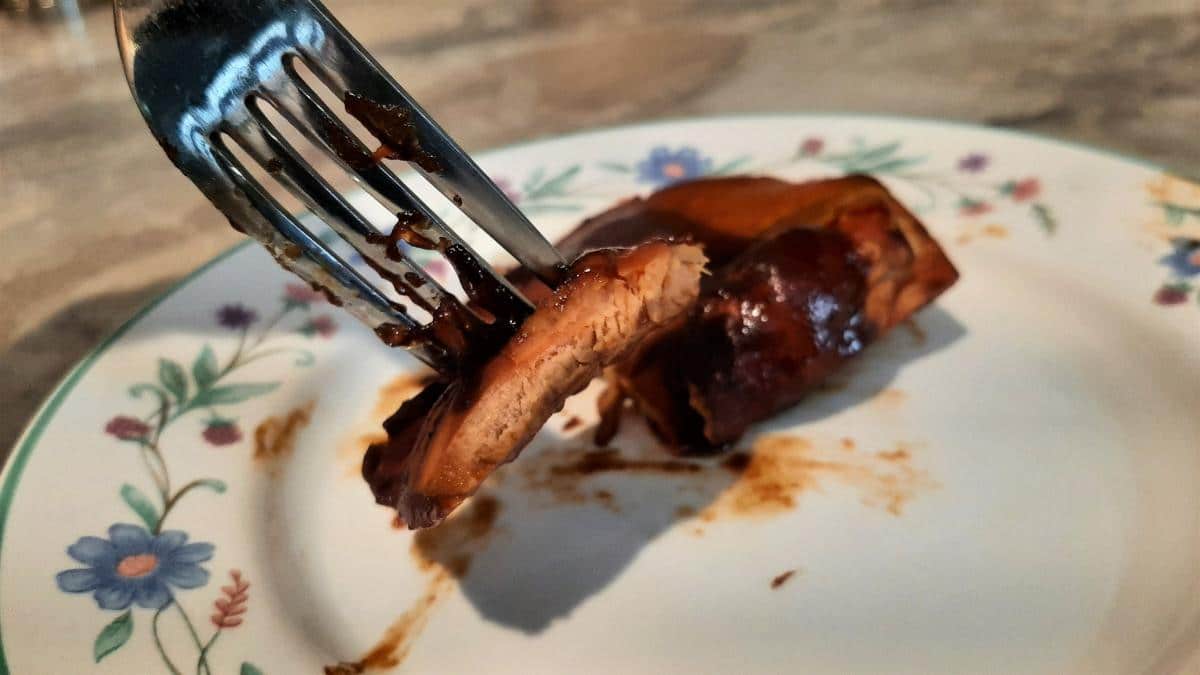
Sautéing
Heat a pan with a splash of water until it’s completely gone. This wet sautéing technique keeps older or drier mushrooms from burning. After the water disappears, add your oil and additions like garlic or shallots. Keep cooking until your mushrooms look golden and any liquid has evaporated, at least 10 minutes.
Breading and Frying
A classic fry of these mushrooms is incredible. Set up a three-stage breading station with flour, beaten eggs, and breadcrumbs. The mushroom goes first in flour, then egg wash, and finally gets coated in seasoned breadcrumbs. Or, you can do flour-egg-flour (no breadcrumbs) for a lighter crust if that’s what you prefer. Heat the oil to 340-350 degrees and fry the mushrooms until golden brown, usually 7-9 minutes.

Grilling
Preheat the grill to medium heat. Give the chicken of the woods mushroom pieces a brush of olive oil or let them soak briefly in beer or wine. Place the mushrooms near the edge of the flame and grill 6-8 minutes per side. A heavy cast iron pan is good for pressing the mushrooms down for even cooking.
Baking/Roasting
Cut the chicken of the woods mushroom into the desired size pieces (strips, chunks, slices). Marinate them in your favorite sauce or dressing for 6-12 hours, or overnight in the refrigerator.
Preheat the oven to 375F. Line a baking tray with parchment or lightly coat with oil and layer the chicken of the woods on it in an even layer. Bake for 15-25 minutes. The time needed depends on how big the pieces.

Chicken of the Woods Long Term Storage and Preservation
Refrigeration
Your fridge is the best spot to keep fresh Chicken of the Woods right after it’s been foraged. Store the mushrooms in brown paper bags or wrap them loosely in paper towels. Put the wrapped mushrooms on a shelf (not the crisper drawer). They’ll stay fresh for 7-10 days this way.
Freezing
Freezing is your best bet for long-term storage. Some people store them raw, but they keep their texture much better if they’re cooked first. You can cook them in a recipe and store them that way. Or, thoroughly sauté or boil the mushroom pieces and store them in plastic freezer bags. If you are cooking them first, let them cool completely before packaging them for the freezer.
To freeze chicken of the woods raw, make sure they are completely dry first to keep their texture intact. Pack clean, dried pieces in freezer bags or vacuum seal them. A pro tip to keep the pieces from sticking together in the bag — coat them in seasoned flour, freeze them on a baking sheet, then move them to freezer bags.
When packed like this, these mushrooms stay good for up to 12 months in the freezer. You can cook these frozen mushrooms without thawing them first.
Dehydration
Dehydration is a great way to preserve chicken of the woods mushrooms if you intend to use them for powder or seasoning. Dehydrated raw and cooked chicken of the woods doesn’t rehydrate the best. The texture gets a bit tough. It’s not completely awful or unusable, but it is the least recommended storage option for chicken of the woods mushroom.
However, dehydrating them and powdering the pieces is a great storage method. You can add the powder to soup stocks as seasoning.
Cut clean mushrooms into half-inch pieces and lay them on dehydrator trays without touching. Start at 110°F for about 10 hours, then drop to 100°F for 3 more hours. You’ll know they’re done when they feel leathery but snap easily. Grind the pieces into powder and store it in an airtight glass jar. We recommend using silica packets to control the moisture.
Even though we don’t recommend it, you can still preserve chicken of the woods pieces by dehydrating them. To do this, cut your mushroom into the desired size. Par-boil the mushrooms for 8-10 minutes. Drain the mushrooms and let them cool completely. Pack into freezer or vacuum seal bags.

Our Favorite Chicken of the Woods Recipes
Just a few of our favorite chicken of the woods mushroom recipes ~
- Garlic Butter Chicken of the Woods
- Fried Chicken of the Woods
- Indian Butter Chicken of the Woods
- Air Fryer Chicken of the Woods
- Cream of Chicken of the Woods Soup
- Drunken Chicken of the Woods
- Pickled Chicken of The Woods
- Chicken of the Woods Jerky
- Chicken Fried Chicken of the Woods
- Chicken of the Woods Mac & Cheese

Common Questions About Cooking Chicken of the Woods
How long should I cook chicken of the Woods mushrooms?
Regardless of which cooking method you use, always cook Chicken of the Woods thoroughly for at least 10 minutes to avoid potential reactions. You can pan-fry, sauté, deep fry, stir-fry, roast, and grill chicken of the woods. It is very versatile.
Can I freeze chicken of the Woods mushrooms?
Yes, you can freeze chicken of the woods mushrooms. They’re best if they’re cooked before freezing, but you can also freeze the mushroom raw.
Are there any safety concerns when eating Chicken of the Woods?
Chicken of the woods is generally safe to eat. However, some people may experience sensitivity to these mushrooms. Anytime you’re trying a new mushroom, only eat a small amount first to see if you have any sensitivities to it. Then, wait 24-48 hours to monitor for any adverse reactions.






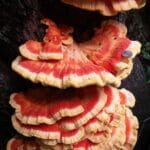
Leave a Reply